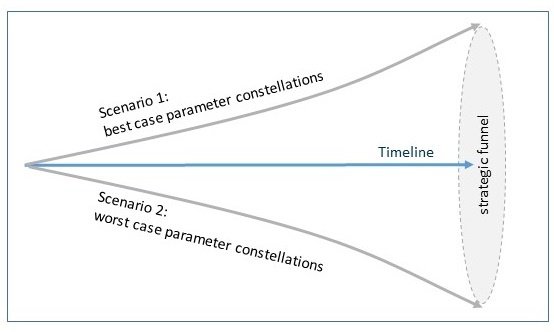Planning means to anticipate the most probable future development of a company. But how can a company handle the uncertainty that is immanent in planning?
The future development of a company depends on a number of side conditions. Many of them can not or only partly be influenced by the company itself: currency exchange rates, market price development, behaviour of competitors etc.
Why you should think about scenarios pro-actively
The logical consequence is that whenever planning data are derived, assumptions have to be made with regards to these uncertain parameters. If a company does not pro-actively control this, the users that do planning will necessarily apply their own assumptions. And here comes the problem: Some people are rather risk averse, some are more optimistic and some others might not even be aware about these uncertainties and their influences on future results at all. So when putting together a company-wide planning, mixing these views might result in inconsistent and uncomparable data.
Scenarios are a pragmatic method to handle the topic of uncertainty and risks. They bundle a set of defined parameters into a „scenario“, e.g. into a „Worst Case“ and a „Best Case“ or into more specific scenarios like „Carve-Out Unit A“ or „Takeover Company XY“. Individual users are then asked to give their view on the things in case this bundle becomes true. If the respective planning tool is sophisticated enough, scenarios can even be partly tool-supported, e.g. by providing separate input sheets, by providing simulation parameters on currency exchange rates, prices etc.
As this sounds very promising, scenarios are a classical feature that is typically requested in any new planning project. However, scenarios are one of the features that are quite often not really used in later operative planning. Why?
Don’t be too optimistic
Scenarios need to be implemented with care. A too optimistic approach can blow up complexity of planning immensely. For example, a company might seek to open scenarios as a very flexible feature, allowing business units or even individual users to open their own scenarios as they wish. This will cause a lot of hick-ups:
- In an integrated planning system, planning of one unit is usually not independent of other units. If one unit opens a scenario in sales planning now, how does this relate to the scenarios other units opened in cost and volume planning? Is integration lost in that case?
- Which scenario will flow into the productive planning numbers at the end?
- Can a user copy changes between scenarios? If so, can a user by accident overwrite the main scenario with his playground scenarios?
- How many scenarios can a unit open and keep under control?
- Will scenarios be rolled forward as well?
- Will the additional data volume (which can be significant!) reduce planning performance? Is that worth it?
The list goes on. Trying to cope with these problems quite often results in extremely complex tool implementations and might even reduce efficiency of planning overall.
Open a “strategic funnel” by centrally defined scenarios
When starting to use scenarios, it is therefore advisable to define and control this functionality centrally. A central planning department can define scenarios for a very limited set of parameter bundles, which will then form the basis of the next planning run. If this is done in a smart way, the result of scenario based planning will in fact open a „strategic funnel“ of potential future development schemes.

This transparency will allow for a better understanding of the impact certain parameters can have on the company’s total results. If this is done repeatedly and combined with later analytical reports, the company will be able to bette runderstand, which critical value drivers actually determine its success. This knowledge is key to increase efficiency and effectiveness of planning.
To summarize: Scenarios are a great feature, if they are applied correctly. If applied wrongly, they will turn into an unneccessary complex functionality that does not add value, but that only adds complexity and reduces efficiency.
You already participated in Benchmark 2017?
Check out the international benchmarking study Benchmark 2017 – Corporate Planning. With a very limited effort you can get valuable insights into improvement potentials and compare your own processes with best-practices of different industries.
More info at Benchmark 2017.com
You want to read more?
You are interested to read more? Our Corporate Planning Maturity Framework provides details on different aspects of planning processes, and how these processes can be optimized. It is ready for download on our website.
Some previous blogs discussed specific topics of planning:
Effectiveness Traps in Planning
Thoughts-on-Planning: How do you know that your planning is “good”?
Thoughts-on-Planning: Do you think that adding detail will improve accuracy?
Thoughts-on-Planning: Do you also play Budget Poker?
Thoughts-on-Planning: Why tools don’t matter THAT much
By Andreas Krüger